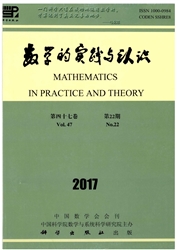

 中文摘要:
中文摘要:
存贷利差收入是银行主要的收入来源,存贷款定价问题是银行经营管理、风险控制的核心之一.在“代理商”模型的基础上,弓【入后悔系数和后悔效用函数:建立了基于双重厌恶银行的期望效用函数,并利用极值理论,确定了最优存贷款利差.双重厌恶期望效用函数反映了银行风险厌恶和后悔厌恶的双重特点,解决了现有研究忽略后悔情绪导致模型出现偏差的问题.从理论上分析了双重厌恶型银行最优的存贷款利差的决策问题,给出了其与市场风险、信用风险以及后悔情绪之间的关系.通过与纯风险厌恶型银行最优决策的对比发现,对于双重厌恶型银行来说,信用风险对存贷利差影响的弹性要小于纯风险厌恶型银行,而后悔厌恶程度越大其弹性就越小.由于后悔心理的存在减小了信用风险对存贷款利差影响的弹性.
 英文摘要:
英文摘要:
The deposit and loan spread income are main source of banking income. Deposit and loan pricing problem is one of the issues of banking operating management and risk controlling. Based on "dealership" model, this paper not only introduces regret coefficient and regret utility function, but also builds the banking expected utility function based on dual aversion and determines the optimal deposit and loan spread by using the extreme value theory. The expected utility function based on dual-aversion reflects the dual characteristics of banks' risk aversion and regret aversion so that it avoids the deviation due to ignoring the regret emotion in the current researches. The decision-making of the banking optimal deposit and loan spread based on dual aversion are analyzed in theory. Their relationship to marker risk, credit risk and regret emotion are expressed. Compared with banking optimal decision- making based on sole risk aversion, the influence elasticity of credit risk on deposit and loan spread is less than that of sole risk aversion banks for dual aversion banks. But the bigger regret aversion, the smaller elasticity. That is, the presence of regret reduces the influence elasticity of the credit risk on deposit and loan spread.
 同期刊论文项目
同期刊论文项目
 同项目期刊论文
同项目期刊论文
 The Establishment of Green Industry Evaluation Index System Based on Dynamic Clustering-----an Empir
The Establishment of Green Industry Evaluation Index System Based on Dynamic Clustering-----an Empir A Credit Risk Evaluation Index Screening Model of Petty Loans for Small Private Business and Its App
A Credit Risk Evaluation Index Screening Model of Petty Loans for Small Private Business and Its App Study on non-structural decision fuzzy set theory based optimal combination weighting model for smal
Study on non-structural decision fuzzy set theory based optimal combination weighting model for smal A Novel Imbalanced Data Classification Approach Based on Logistic Regression and Fisher Discriminant
A Novel Imbalanced Data Classification Approach Based on Logistic Regression and Fisher Discriminant 期刊信息
期刊信息
